
hotline:
17715390137
Tel/Wechat:
18101240246 (Technology)
0512-68565571
Email:mxenes@163.com (Sales Engineer)bkxc.bonnie@gmail.com
Scan the code to follow or search the official account on WeChat:
2D Materials Fronrier After paying attention,
click on the lower right corner to contact us,
Enter enterprise WeChat.
Professional Services Online

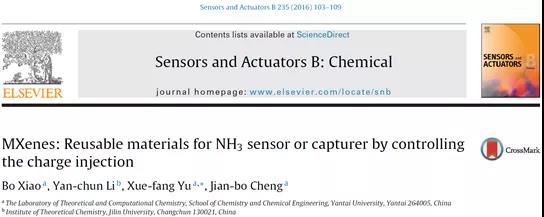
[Background introduction]
Ammonia (NH3) is one of the most important chemical resources in the chemical industry. It is widely used in chemical systems, fertilizer production, food processing, and reduction of NOx gas in diesel vehicles. On the other hand, NH3 is a highly toxic compound that is very harmful to humans and animals because they can inhibit the consumption of oxygen by body tissues. Therefore, it is necessary to design new materials to make high-efficiency ammonia traps and / or sensors. Now commonly used ammonia gas capture materials Mg (NH3) 6Cl2, Sr (NH3) 8Cl2, etc.Although they can effectively capture ammonia gas, but want to release the captured ammonia gas, or require multi-step reaction, or high temperature (> 450K), so it is difficult to hinder their application in the field of energy storage. The main disadvantage of the existing ammonia sensor is that after the ammonia gas is detected, it cannot be completely restored to the initial state or the recovery time is long at room temperature. Therefore, the main challenge in designing an ammonia trap or sensor is how to effectively release ammonia from the material.
[Achievement Profile]
In 2016, Dr. Yu Xuefang of Yantai University reported a systematic study of the adsorption / desorption of NH3 from neutral and negatively charged M2CO2. The results show that by changing the charge state of M2CO2, the effective release / capture of NH3 on M2CO2 can be controlled or even reversed. The specific reason for this behavior is directly related to the significant change in the charge state on the M2CO2 metal atom after the charge injection. This study broadened the application range of MXene, not only as a battery material, but also as a reusable NH3 sensor or trap material through the control of charge injection.
The results were published online in Sensors and Actuators B: Chemical: MXenes: Reusable materials for NH3 sensor or capturer by controlling the charge injection
[Picture and text guide]

Figure 1 Top view (a) and side view (b) of the adsorption of NH3 molecules on a single layer of Zr2CO2.
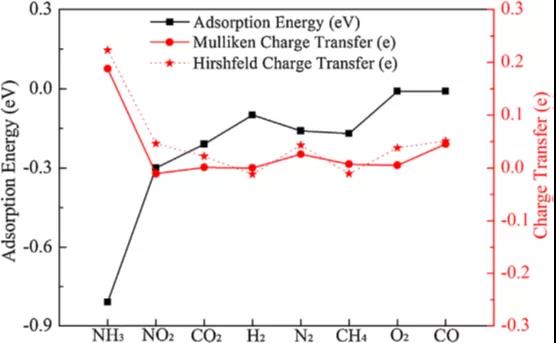
Fig. 2 Adsorption energy of gas molecules on Zr2CO2 and Mulliken / Hirshfeld charge transfer.
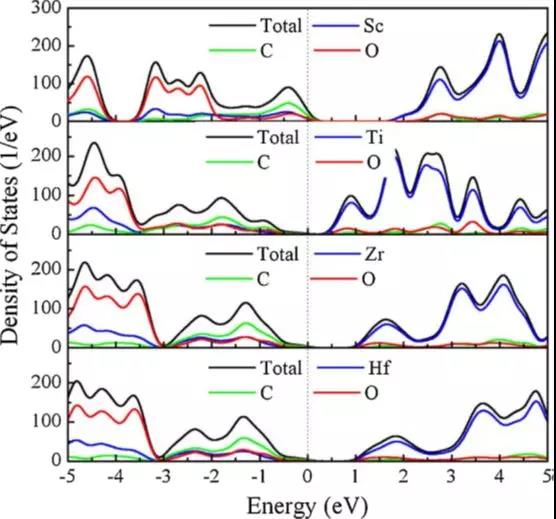
The surface of Fig. 3 is the partial density of semiconductor MXenes containing oxygen functional groups.
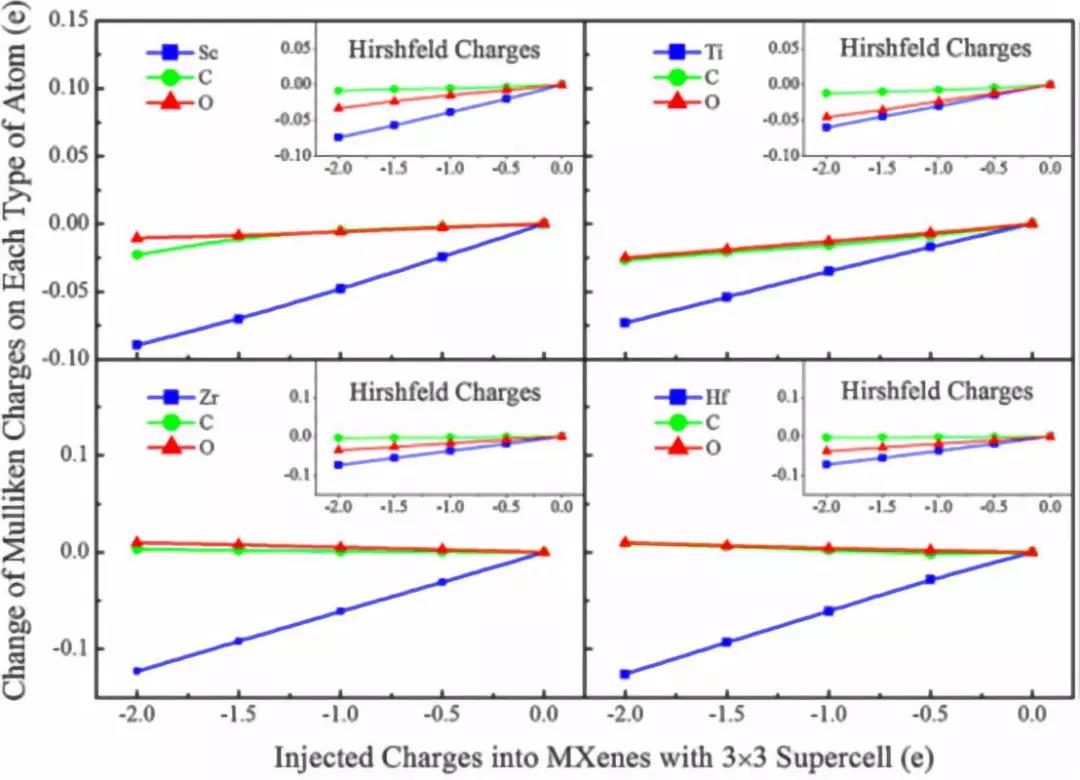
Figure 4 Mulliken and Hirshfeld (inset) charge distributions of various types of atoms in charged MXenes compared to neutral MXenes.
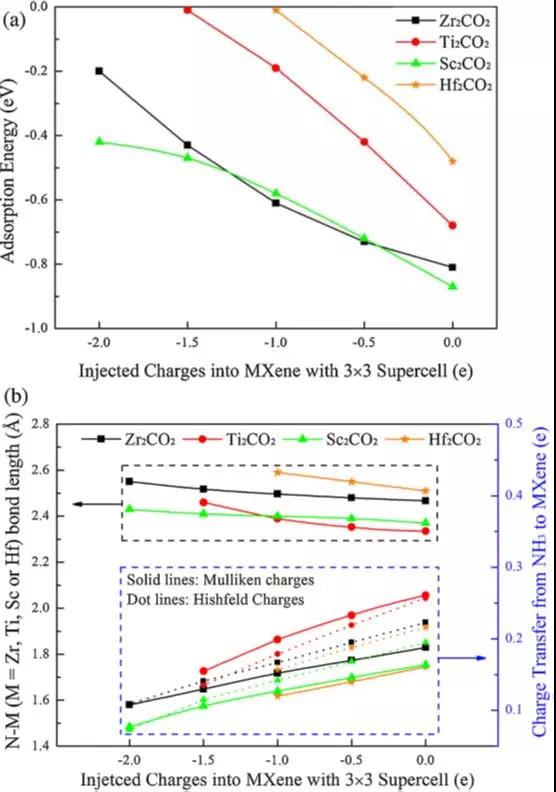
Fig. 5 (a) Adsorption energy and (b) N-M (M = Sc, Ti, Zr and Hf) bond length and Mulliken / Hirshfeld charge transfer of NH3 on single layer Sc2CO2, Ti2CO2, Zr2CO2 and Hf2CO2 It is noted that the adsorption energy of ammonia on Sc2CO2, Ti2CO2 and Zr2CO2 is obtained under the PBE-D2 method, while the adsorption energy on Hf2CO2 uses only the PBE function.
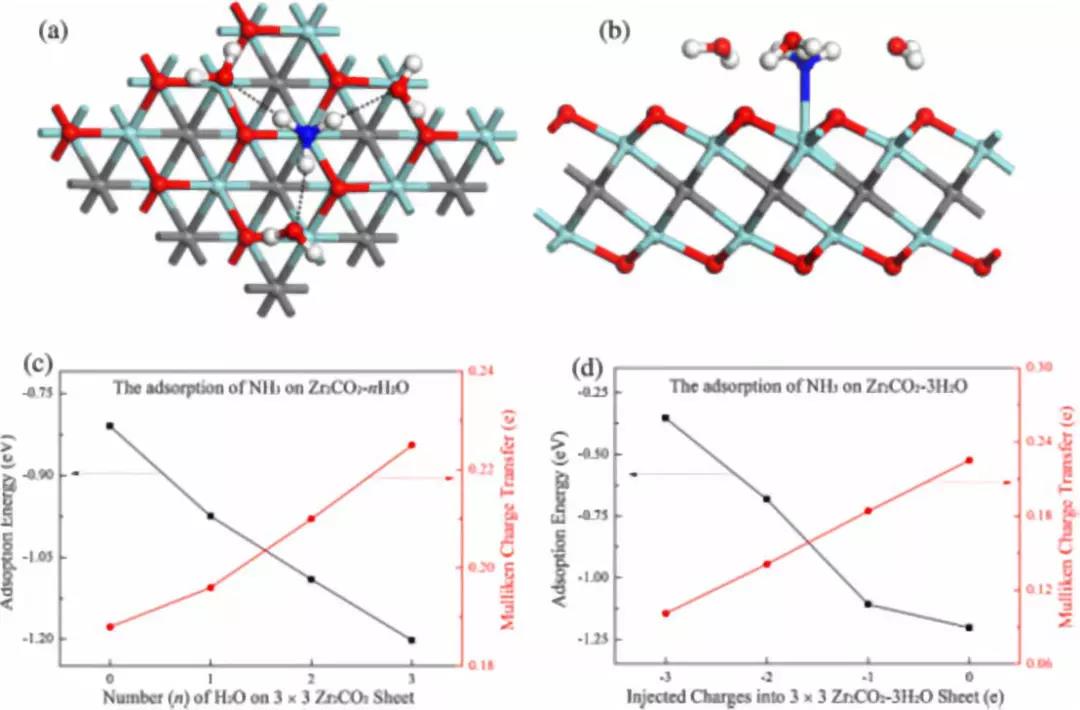
Figure 6 Top view (a) and side view (b) of the adsorption of NH3 molecules on a single layer of Zr2CO2 covered by water, (c) the corresponding adsorption energy and Mulliken charge transfer of NH3 and a charged Zr2CO2-nH2O system, (d) NH3 and The corresponding adsorption energy and Mulliken charge transfer of the charged Zr2CO2-3H2O system.
[Summary of this article]
The interaction between NH3 and semiconductor MXenes with oxygen-containing functional groups (M2CO2, M = Sc, Ti, Zr and Hf) was studied using first-principles. The results show that NH3 has strong chemisorption on M2CO2 and has obvious charge transfer. In particular, the strength of the interaction between NH3 and M2CO2 can be significantly weakened by the introduction of electrons into the system, eventually leading to the release of NH3 gas from M2CO2. Taking Zr2CO2 as an example, compared with other gas molecules (such as H2, CH4, CO, CO2, N2, NO2, O2, etc.), only NH3 has a stronger chemisorption on Zr2CO2. More importantly, the adsorption behavior of Zr2CO2 by NH3 has undergone a change from chemical adsorption (Eads = 0.81 eV) to physical adsorption (Eads = 0.20 eV), which is when two extra electrons are introduced to the 3 × 3 Zr2CO2 sheet Happened from time to time. The results in this paper highlight a feasible route for the convenient release of NH3 from semiconductor MXenes with oxygen-containing functional groups on the surface, which is the use of charge injection. In summary, this paper considers that semiconductor MXenes with oxygen-containing functional groups on the surface are good NH3 capture / sensor materials. Highly reversible release and capture of NH3 can be achieved by controlling the charge state on the system.
Literature link
http://dx.doi.org/10.1016/j.snb.2016.05.062

| Reminder: Beijing Beike New Material Technology Co., Ltd. supplies products only for scientific research, not for humans |
| All rights reserved © 2019 beijing beike new material Technology Co., Ltd 京ICP备16054715-2号 |